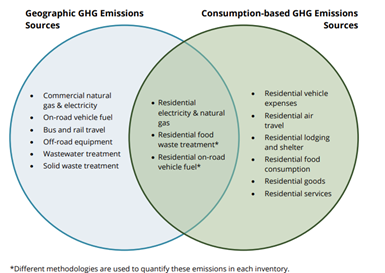A consumption-based emissions inventory (CBEI) is an estimate of the greenhouse gas emissions associated with the activity of all residents of a geographic area. It is equivalent to a personal household carbon footprint estimate, except calculated for all households in a jurisdiction.
How is this different?
CBEIs differ from traditional geographic-based greenhouse gas inventories. Traditional inventories factor in all emissions that occur within a city's borders. In contrast, CBEIs consider emissions that may occur anywhere in the world that directly or indirectly result from the activities of a city’s residents.
Geographic and consumption-based approaches are complementary and partially overlapping. Both will look at residents’ local, direct emissions (e.g., from driving or home heating). A geographic inventory will also consider the emissions from local businesses and visitors but ignore anything outside the city’s boundaries. Meanwhile, a consumption-based inventory will omit the local emissions from businesses and visitors, but instead account for emissions associated with residents’ travel to other cities, as well as the emissions associated with producing the goods and services they purchase or consume. Those consumption-based emissions may occur anywhere in the world.

These consumption estimates are developed using a model that primarily considers six key household variables:
- household size (people per household)
- household income
- vehicle ownership (cars per household)
- home size (rooms per home)
- education (bachelor's degree or higher for at least one member of the household)
- homeownership
These variables often have clear, direct effects on consumption. For instance, larger homes generally take more energy to heat or cool, while more people per household means more food consumed per household.